Dingbat 2.0: The Iconic Los Angeles Apartment
as Projection of a Metropolis
Dingbat 2.0 gives an often-maligned Los Angeles building type its long overdue moment in the sun, not only advancing a sophisticated typology of dingbats, but also reimagining the potential of the dingbat for the twenty-first century—at a moment when the imperative to create livable and modest affordable housing is more pressing than ever.
– Ken Bernstein, Principal City Planner, Los Angeles Department of City Planning and Office of Historic Resources

Dingbat 2.0: The Iconic Los Angeles
Apartment as Projection of a Metropolis
is a publication which discusses the influence, both past and future, of the dingbat apartment building on urban development, cultural iconography and architectural history. Existing and historic conditions of Los Angeles’ dingbats and dingbat neighborhoods are examined through short essays by prominent architectural critics and urban theorists, as well as graphic and photo-documentation of dingbats and dingbat neighborhoods. Also included in the publication are winning and selected entries from the Dingbat 2.0 Competition, held in 2010 by the Los Angeles Forum for Architecture and Urban Design.
In Los Angeles the dingbat grew out of the city’s rapid postwar expansion period and defined a pervasive vernacular that still weaves through the space of L.A.’s neighborhoods and the decades of their development. For more than half a century, this idiosyncratic typology has been studied, vilified, praised, and often misunderstood – as much for being ugly and ordinary as for being innovative, iconoclastic, and distinctly “L.A.” As a housing type, the dingbat has aided the sprawl for which Los Angeles is infamous, while simultaneously aiding in the creation of a consistent urban density achieved by few other cities. Dingbat 2.0 speculates on re-envisioning the Dingbat, and in so doing, offering visions for an emerging 21st Century Los Angeles.
Essays by Barbara Bestor, Aaron Betsky, James Black, John Chase, Dana Cuff, Thurman Grant, John Kaliski, John Southern, Joshua G. Stein, Steven A. Treffers, and Wim de Wit. Photographic series by Judy Fiskin, Paul Redmond, and Lesley Marlene Siegel.
The Dingbat 2.0 publication is available for
purchase from DoppelHouse Press here.
Dingbat 2.0: The Iconic Los Angeles Apartment
as Projection of a Metropolis
Edited by Thurman Grant and Joshua G. Stein
Published by DoppelHouse Press in cooperation with
The L.A. Forum for Architecture and Urban Design
![]()
Book design by Jessica Fleischmann / still room
Cover drawing by Thurman Grant, based on concept
by Jessica Fleischmann / still room
In Los Angeles the dingbat grew out of the city’s rapid postwar expansion period and defined a pervasive vernacular that still weaves through the space of L.A.’s neighborhoods and the decades of their development. For more than half a century, this idiosyncratic typology has been studied, vilified, praised, and often misunderstood – as much for being ugly and ordinary as for being innovative, iconoclastic, and distinctly “L.A.” As a housing type, the dingbat has aided the sprawl for which Los Angeles is infamous, while simultaneously aiding in the creation of a consistent urban density achieved by few other cities. Dingbat 2.0 speculates on re-envisioning the Dingbat, and in so doing, offering visions for an emerging 21st Century Los Angeles.
Essays by Barbara Bestor, Aaron Betsky, James Black, John Chase, Dana Cuff, Thurman Grant, John Kaliski, John Southern, Joshua G. Stein, Steven A. Treffers, and Wim de Wit. Photographic series by Judy Fiskin, Paul Redmond, and Lesley Marlene Siegel.
The Dingbat 2.0 publication is available for
purchase from DoppelHouse Press here.
Dingbat 2.0: The Iconic Los Angeles Apartment
as Projection of a Metropolis
Edited by Thurman Grant and Joshua G. Stein
Published by DoppelHouse Press in cooperation with
The L.A. Forum for Architecture and Urban Design

Book design by Jessica Fleischmann / still room
Cover drawing by Thurman Grant, based on concept
by Jessica Fleischmann / still room
The Los Angeles Dingbat Apartment

The Hauser dingbat apartment[James Black]
The dingbat apartment blankets the urbanized flatlands of Southern California like the chaparral covering the surrounding rugged hills and valleys. Emerging in the early 1950s this new native species of apartment structures found its niche in the building boom of the late ’50s and ’60s and quickly spread across the fertile expanse of postwar Los Angeles and the American Southwest. The dingbat easily insinuated itself into Los Angeles’ expansive grid of single-family residences, replacing individual homes and taking over entire neighborhoods, subtly, yet profoundly transforming the landscape of the city.
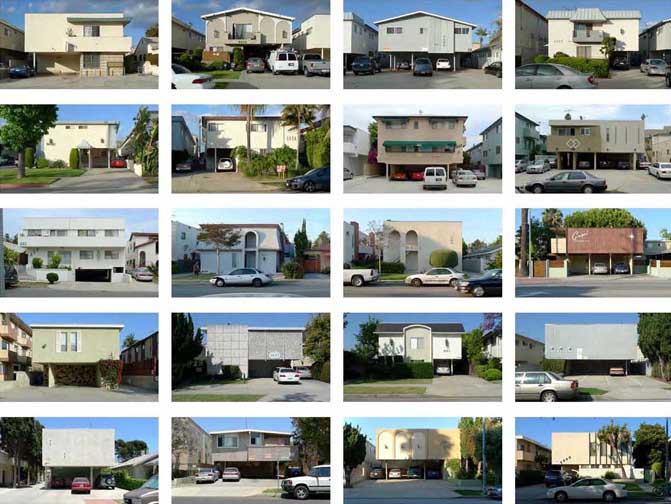
Dingbat Grid [James Black]
The dingbat is usually a two-story walk-up built of stucco over wood framing with an often extravagantly dolled-up facade—Mansard, Tiki, Mod, anything fantastic or exotic. However, its impact on the built and cultural context of Los Angeles is much more complex and nuanced than the simple structure might suggest.
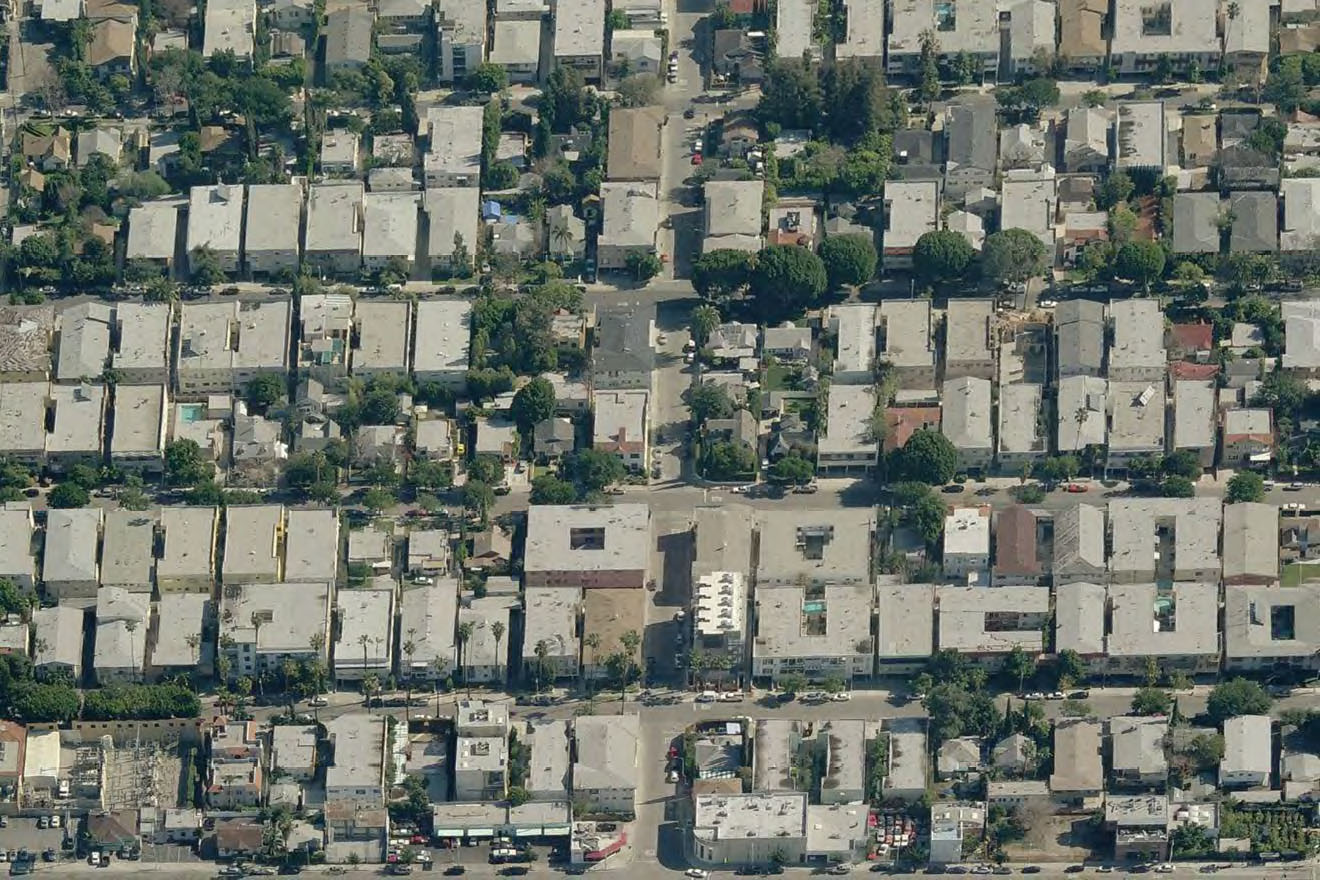
Aerial view of dingbat neighborhood in West Los Angeles
The dingbat is the quintessential Los Angeles apartment building—inhabited by hundreds of thousands of Angelenos who, despite the catchy script on the facade, never realized their apartment type had a name. The dingbat is also quintessentially Los Angeles in its contradictions: provisional yet persistent, pretentious yet mundane, eclectic yet generic, and an agent of both urban density and sprawl.
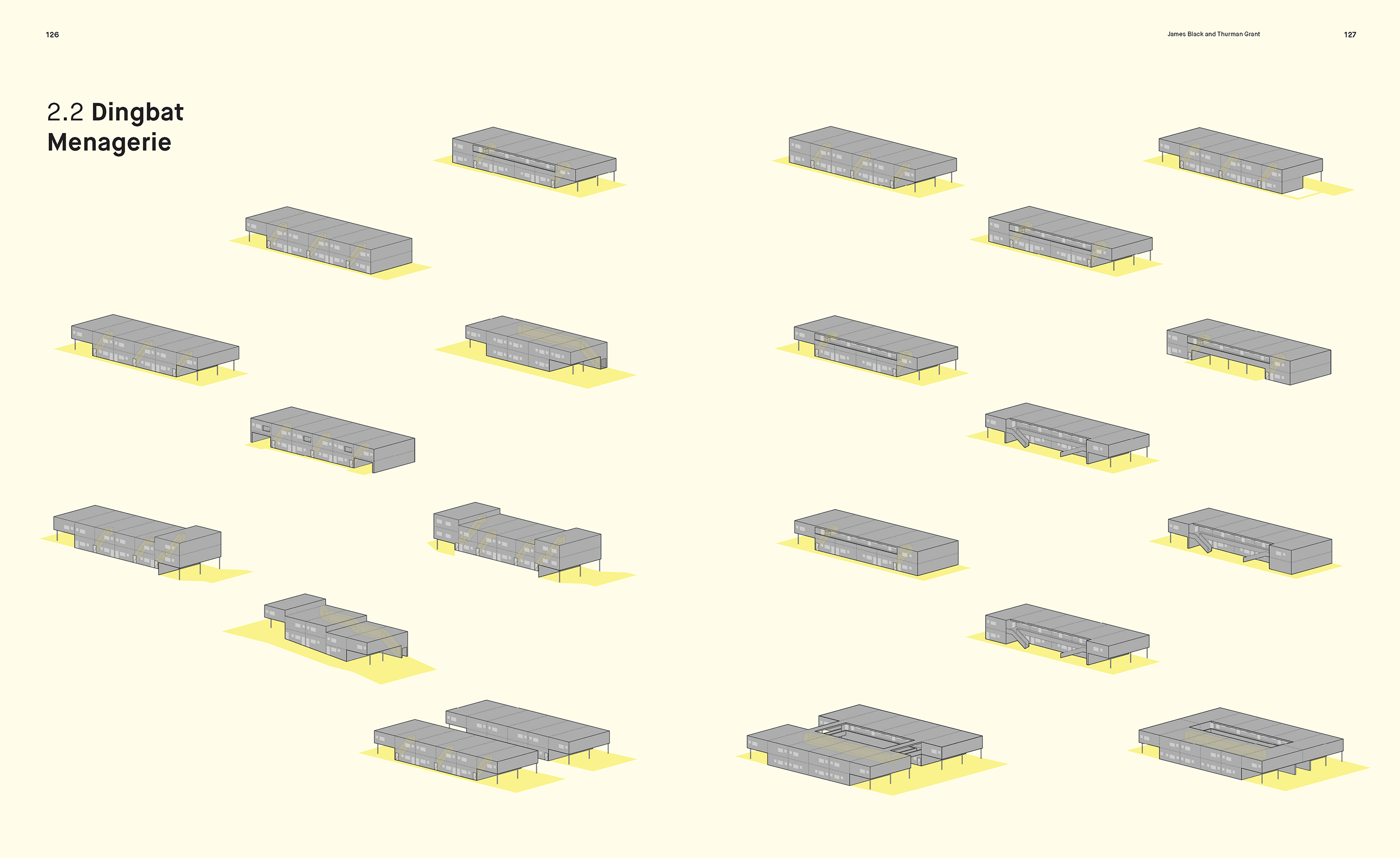 Dingbat Menagerie [Thurman Grant]: Drawings of various sub-types of dingbat apartments, from “Field Guide to Dingbats,” featured in Dingbat 2.0.
The dingbat, while a product of the ’50s and ’60s, is so
firmly rooted in the ethos of the city that it remains relevant in looking
toward the city’s future. Given the degree to which Los Angeles’ development
influenced or predicted a global trend in decentralized urban growth, the
city’s efforts to densify may well hold valuable lessons for the role that
housing plays in the current international wave of city-making, including
determining the ideal scale for the grain of new development and questioning
the role of the vernacular, the generic, the popular, and the populist.
Dingbat Menagerie [Thurman Grant]: Drawings of various sub-types of dingbat apartments, from “Field Guide to Dingbats,” featured in Dingbat 2.0.
The dingbat, while a product of the ’50s and ’60s, is so
firmly rooted in the ethos of the city that it remains relevant in looking
toward the city’s future. Given the degree to which Los Angeles’ development
influenced or predicted a global trend in decentralized urban growth, the
city’s efforts to densify may well hold valuable lessons for the role that
housing plays in the current international wave of city-making, including
determining the ideal scale for the grain of new development and questioning
the role of the vernacular, the generic, the popular, and the populist.
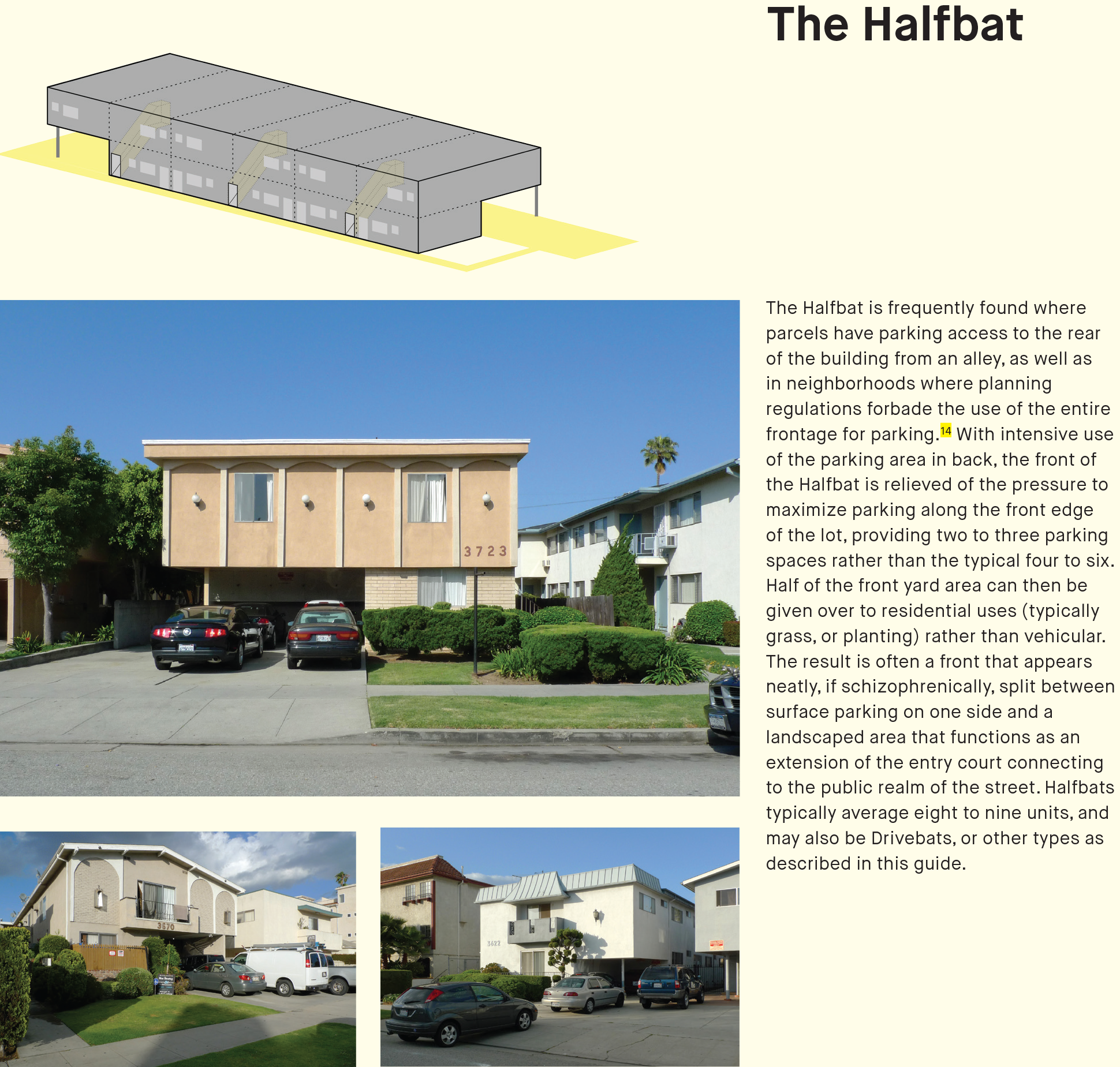 Dingbat subtypes include the Halfbat, so-named for the splitting of the front yard into areas for parking and landscape. The Halfbat emerged largely through regulations developed in response to the endless concrete wastelands created when dingbats were built across several adjacent lots [”Field Guide to Dingbats,” James Black and Thurman Grant].
Dingbat subtypes include the Halfbat, so-named for the splitting of the front yard into areas for parking and landscape. The Halfbat emerged largely through regulations developed in response to the endless concrete wastelands created when dingbats were built across several adjacent lots [”Field Guide to Dingbats,” James Black and Thurman Grant]. Dingbat 2.0 Competition
Dingbat 2.0: The Iconic Los Angeles
Apartment as Projection of a Metropolis is the culmination of a multi-year
project by the Los Angeles Forum for Architecture
and Urban Design to raise critical debate around Los Angeles’ vernacular housing and its
repercussions for the city, and for urban development
across the globe. In 2010, the Forum focused on the dingbat apartment and the
larger issue of an aging vernacular modern housing stock within the contemporary city.
Through an international design competition, exhibition, and series of panel
discussions, the Forum engaged architects, historians, critics, planners, and
urbanists to discuss the past, present, and future of the dingbat. The topic
resonated with the design community and the general public in Los Angeles and
beyond, who were eager to debate a building type so iconic and ubiquitous
within Los Angeles, yet rarely discussed outside the issues of aesthetics and
taste.
Dingbat 2.0 Competition Jury:
-Barbara Bestor, Principal, Bestor Architecture & Author, Bohemian Modern,/ Chair, Graduate School of Architecture at Woodbury University -John Chase / Author / Urban Designer, City of West Hollywood
-Teddy Cruz / Principal, Estudio Teddy Cruz, San Diego / Associate Professor, UCSD, Visual Arts Department
-Dana Cuff / Director cityLAB – UCLA/AUD
-Neil Denari / Principal, NMDA, Los Angeles / Professor, UCLA/AUD
-Joshua Prince-Ramus /Principal, REX, New York
Dingbat as Urban Typology Discussion Panelists:
-John Chase -Alan Loomis, Principal Urban Designer, City of Glendale and Delirious L.A. founder -Roger Sherman, Principal of Roger Sherman Architecture and Urban Design, and Co-Director at cityLAB -Mott Smith, Principal of Civic Enterprise Development
Dingbat as Cultural Icon Discussion Panelists:
-Barbara Bestor -Christopher Hawthorne, Los Angeles Times Architecture Critic -Mimi Zeiger, Editor, Loud Paper Architectural Zine and Blog -Alan Hess, Architecture Critic & Author of numerous books, including Palm Springs Weekend and Googie Redux:Ultramodern Roadside Architecture
Spring, 2010
![]()
![]()
Microparcelization, by Footprint: Carmen Cham, James Black & Tyler Goss [First Place]
A portion of the Dingbat 2.0 publication addresses the future of the dingbat and its influence on the identity of the city of Los Angeles. The winning entries from the LA Forum’s Dingbat 2.0 competition served as provocation for the continued influence of the dingbat. Images and text from these projects, along with analysis, jury deliberations and panel discussions, reveal the far-reaching and potentially long-lasting complex role of the dingbat in the city.
![]()
The Flip, Caroline Filice Smith [Shared Third Place]
While the subject of the publication is understood to be quintessentially “L.A.”, the competition jury and panel discussions revolving around the competition will link this typology to larger cultural and developmental patterns so as to question the ways in which specific housing types work to define the identity of any contemporary city.
![]()
LAMobility, Jonathan Kleinhample
![]()
In the summer of 2010 the Los Angeles Forum for Architecture and Urban Design presented the Dingbat 2.0 Exhibition, featuring winning and selected entries from the recently completed Dingbat 2.0 Housing Competition, which challenged architects and designers to reconsider Los Angeles’ ubiquitous ‘dingbat’ apartment building for the 21st century. Historic documentation of existing dingbat apartment buildings was featured in the exhibition, including images from the 1998 film Slums of Beverly Hills and work by artist Judy Fiskin, from her series Dingbat, 1982-83.
Download the exhibition Gallery Guide PDF to view the competition winners as well as competition jury commentary.
The Dingbat 2.0 Project was sponsored by the National Endowment for the Arts, the City of Los Angeles Department of Cultural Affairs, Enterprise Holdings Foundation, the Woodbury University School of Architecture, and the Los Angeles Forum for Architecture and Urban Design. Archinect was the media sponsor for the competition, and printing for the exhibition was generously provided by Ford Graphics. The Dingbat 2.0 publication was also funded by a Kickstarter crowd-funding campaign.
Field Guide to Dingbats
“Field Guide to Dingbats” is a section of the Dingbat 2.0 Publication (April 2016), and documents elements of dingbats, identifies dingbats by types, and looks at dingbat neighborhoods in Los Angeles.
The original “Field Guide to Dingbats” was created by the LA Forum as a reference for the 2010 Dingbat 2.0 Competition. The original Field Guide has several small articles and references regarding Dingbat apartment buildings, as well as a chapter from John Chase's Book Glitter Stucco & Dumpster Diving, which covers the history and types of 'stucco box' apartments that are synonymous with Dingbats.
![]()
Cover of 2010 Field Guide to Dingbats
Download here: Field Guide to Dingbats
INDEX:
1. Excerpts from Los Angeles, The Architecture of Four Ecologies, Reyner Banham - 1 page
2. City of L.A. Dingbat Preservation Plan (Draft) - 2 pages Available online: http://www.preservation.lacity.org
3. “Dingbat Culture”, Mimi Zeiger - 2 pages Originally published in READYMADE magazine’s digital preview issue.
4. “Apartment Living is Great - Lesley Marlene Siegel”, John Chase - 2 pages
Originally published in the LA Forum’s 1995 Newsletter “Urban Landscapes.”
5. “The Stucco Box” - Excerpt from Glitter Stucco and Dumpster Diving, John Chase - 36 pages The Stucco Box, by John Chase (with John Beach) is reproduced with permission from the author and publisher Verso from the book Glitter Stucco and Dumpster Diving. The article was original published in Home Sweet Home: American Domestic Vernacular Architecture, Craft and Folk Art Museum, Los Angeles; Rizzoli, in 1983.
Dingbat 2.0 Competition Jury:
-Barbara Bestor, Principal, Bestor Architecture & Author, Bohemian Modern,/ Chair, Graduate School of Architecture at Woodbury University -John Chase / Author / Urban Designer, City of West Hollywood
-Teddy Cruz / Principal, Estudio Teddy Cruz, San Diego / Associate Professor, UCSD, Visual Arts Department
-Dana Cuff / Director cityLAB – UCLA/AUD
-Neil Denari / Principal, NMDA, Los Angeles / Professor, UCLA/AUD
-Joshua Prince-Ramus /Principal, REX, New York
Dingbat as Urban Typology Discussion Panelists:
-John Chase -Alan Loomis, Principal Urban Designer, City of Glendale and Delirious L.A. founder -Roger Sherman, Principal of Roger Sherman Architecture and Urban Design, and Co-Director at cityLAB -Mott Smith, Principal of Civic Enterprise Development
Dingbat as Cultural Icon Discussion Panelists:
-Barbara Bestor -Christopher Hawthorne, Los Angeles Times Architecture Critic -Mimi Zeiger, Editor, Loud Paper Architectural Zine and Blog -Alan Hess, Architecture Critic & Author of numerous books, including Palm Springs Weekend and Googie Redux:Ultramodern Roadside Architecture
Selected Projects from the Dingbat 2.0 Competition
Los Angeles Forum for Architecture and Urban DesignSpring, 2010


Microparcelization, by Footprint: Carmen Cham, James Black & Tyler Goss [First Place]
A portion of the Dingbat 2.0 publication addresses the future of the dingbat and its influence on the identity of the city of Los Angeles. The winning entries from the LA Forum’s Dingbat 2.0 competition served as provocation for the continued influence of the dingbat. Images and text from these projects, along with analysis, jury deliberations and panel discussions, reveal the far-reaching and potentially long-lasting complex role of the dingbat in the city.
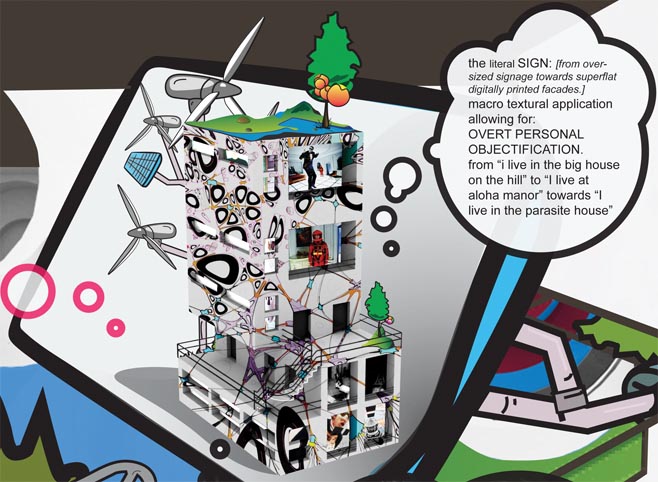
The Flip, Caroline Filice Smith [Shared Third Place]
While the subject of the publication is understood to be quintessentially “L.A.”, the competition jury and panel discussions revolving around the competition will link this typology to larger cultural and developmental patterns so as to question the ways in which specific housing types work to define the identity of any contemporary city.

LAMobility, Jonathan Kleinhample
Dingbat 2.0 Exhibition
WUHO Gallery, Hollywood, Summer, 2010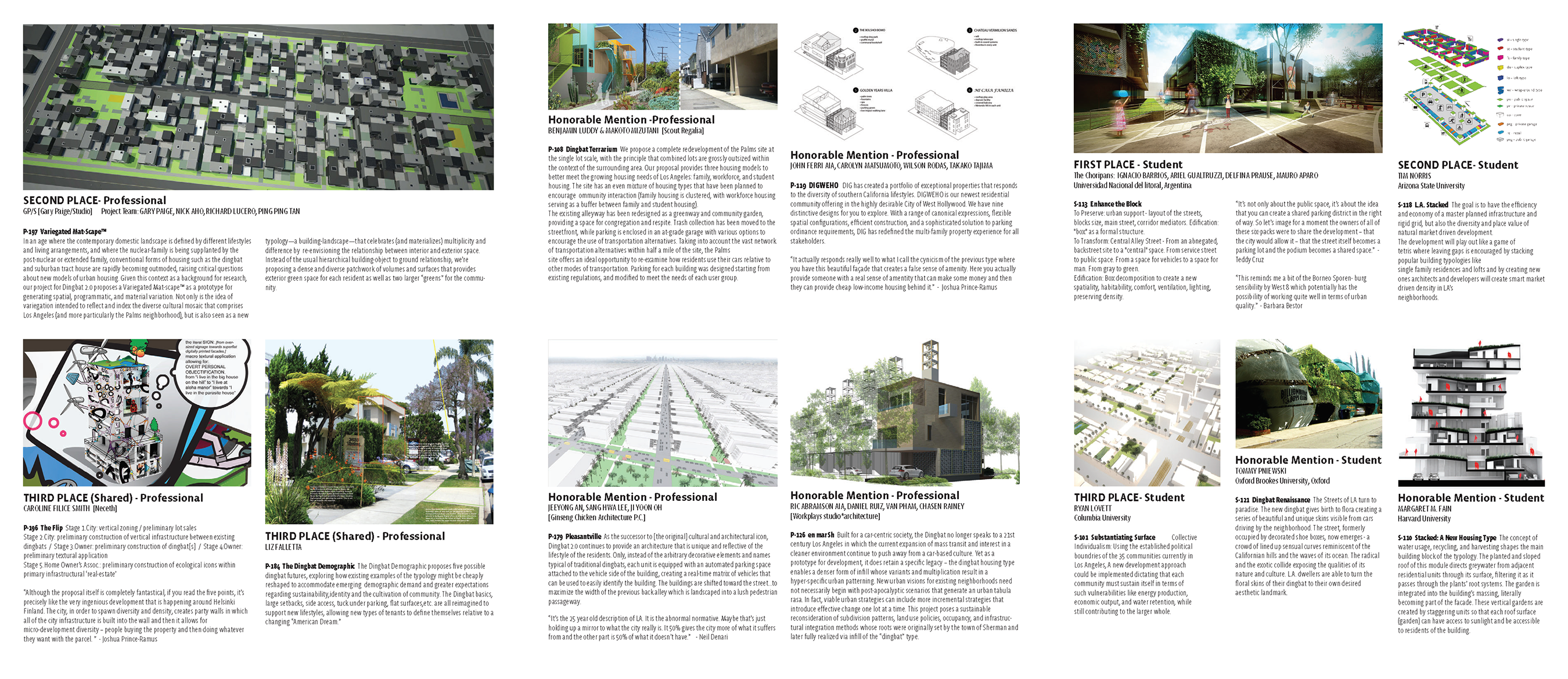
In the summer of 2010 the Los Angeles Forum for Architecture and Urban Design presented the Dingbat 2.0 Exhibition, featuring winning and selected entries from the recently completed Dingbat 2.0 Housing Competition, which challenged architects and designers to reconsider Los Angeles’ ubiquitous ‘dingbat’ apartment building for the 21st century. Historic documentation of existing dingbat apartment buildings was featured in the exhibition, including images from the 1998 film Slums of Beverly Hills and work by artist Judy Fiskin, from her series Dingbat, 1982-83.
Download the exhibition Gallery Guide PDF to view the competition winners as well as competition jury commentary.
The Dingbat 2.0 Project was sponsored by the National Endowment for the Arts, the City of Los Angeles Department of Cultural Affairs, Enterprise Holdings Foundation, the Woodbury University School of Architecture, and the Los Angeles Forum for Architecture and Urban Design. Archinect was the media sponsor for the competition, and printing for the exhibition was generously provided by Ford Graphics. The Dingbat 2.0 publication was also funded by a Kickstarter crowd-funding campaign.
Field Guide to Dingbats
[2010 version]
“Field Guide to Dingbats” is a section of the Dingbat 2.0 Publication (April 2016), and documents elements of dingbats, identifies dingbats by types, and looks at dingbat neighborhoods in Los Angeles.
The original “Field Guide to Dingbats” was created by the LA Forum as a reference for the 2010 Dingbat 2.0 Competition. The original Field Guide has several small articles and references regarding Dingbat apartment buildings, as well as a chapter from John Chase's Book Glitter Stucco & Dumpster Diving, which covers the history and types of 'stucco box' apartments that are synonymous with Dingbats.

Cover of 2010 Field Guide to Dingbats
Download here: Field Guide to Dingbats
INDEX:
1. Excerpts from Los Angeles, The Architecture of Four Ecologies, Reyner Banham - 1 page
2. City of L.A. Dingbat Preservation Plan (Draft) - 2 pages Available online: http://www.preservation.lacity.org
3. “Dingbat Culture”, Mimi Zeiger - 2 pages Originally published in READYMADE magazine’s digital preview issue.
4. “Apartment Living is Great - Lesley Marlene Siegel”, John Chase - 2 pages
Originally published in the LA Forum’s 1995 Newsletter “Urban Landscapes.”
5. “The Stucco Box” - Excerpt from Glitter Stucco and Dumpster Diving, John Chase - 36 pages The Stucco Box, by John Chase (with John Beach) is reproduced with permission from the author and publisher Verso from the book Glitter Stucco and Dumpster Diving. The article was original published in Home Sweet Home: American Domestic Vernacular Architecture, Craft and Folk Art Museum, Los Angeles; Rizzoli, in 1983.